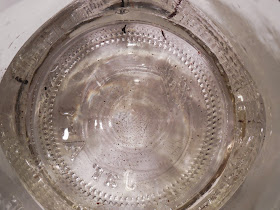Got snow? Here are 2 of my favorite snow experiments to do with children. They are also the EASIEST snow experiments to set up. The best part is, you can do both at the same time!
So if you've just had a fresh snow, or even if you've only got dirty old snow lying around, grab a container and get experimenting! All you need is a transparent container and something to cover the top with.
 | ||
| Step 2: Observe melted snow. Look at the difference in volume! |
Water has many amazing properties. When it is in its liquid state, it is more dense than when it is in its frozen state. In other words, more water molecules are packed into a smaller space. This is why an ice cube, or even an iceberg floats. When water is in its solid state of matter it is less dense than when it is in its liquid state.
This can lead to some really interesting discussion. What would happen if all the snow melted today? What would it be like if the snow was as dense as water? What would happen if we dumped all the snow into the ocean? What else do we know about ice and snow? Does the lake freeze all the way to the bottom? Where does frost come from? What makes an icicle?
What is in the Snow?
The second experimental question you can explore with this jar of snow is: Is snow clean? What is in the snow?
I particularly like this second question as many of my students and my children like to eat snow. No matter how white and new the snow looks, you'll see that your sample has tiny bits of things floating in it once it has melted. This might give your children, (or even you?) some pause when it comes to munching on snow!
Snow needs tiny dust particles in order for its beautiful ice crystals to form. [There are some great links on frost and snow crystal formation in my post from earlier this week- "Frozen Bubbles and the Science of Ice Crystals".]
In addition to these little bits of dust, there can be pollutants in the air and other debris that has blown around with the snow. Depending on where you are, eating snow most likely won't do you harm, but it is good to know that it is not necessarily as clean as it looks!
This experiment can lead to discussion about snow formation and what floats around in the air. Do you have a favorite snow experiment?
This experiment can lead to discussion about snow formation and what floats around in the air. Do you have a favorite snow experiment?




No comments:
Post a Comment